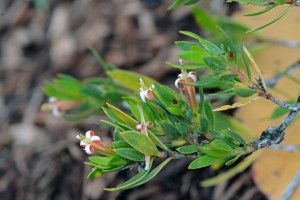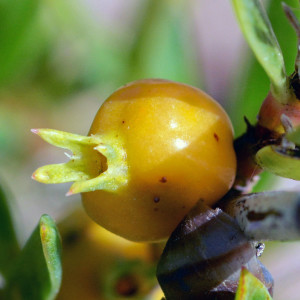My front yard is a problem. It faces south, and it’s very hot and dry. The soil is sandy, and because much of the front yard is reclaimed from a time when the street was wider, there’s a lot of crushed limestone under that sand layer, making for tough digging: those loosely compacted rocks are just a few inches below the sand in most areas. Most of the plants I put out there shrivel up and die because I’m not going to get out there and hand water them year-round. That’s just not something I’m going to do. Sure, I’ll water plants in (2-3 months of daily at first then every other day hand watering), but after that, they’re on their own. So I need plants that are used to hard times, hot weather, and dry conditions.
You can bet that the following description of Beach Creeper (Ernodea littoralis) in Rufino Osorio’s Gardener’s Guide to Florida’s Native Plants made me sit up and take notice:
Beach creeper is a tough, indestructible groundcovering shrub restricted to coastal sites in sandy or rocky areas.… When happily situated, it may cover fairly sizable areas, and it is being recommended as a groundcover for hot, dry, difficult areas.
I mean, how much more perfect can you get?
So when my landscaping consultant came down for her biannual maintenance over at mom’s (the old house), I asked her to swing by my place and make some recommendations for the site. She allowed as to how Ernodea might do really well here, and I was not slow to take up the suggestion.
I immediately began hoeing away, clearing the weedy patch of dirt of its remnant mix of turf, mexican clover, Virginia pepper, and wireweed (to mention only the most dominant species). After that it was just a matter of deciding how much of what to plant where, getting the plants, mulching the beds, watering them in, weeding every day, and constantly trying to see what needed to be done next. No problem, right?
As it happens, I decided to put in seven little creepers out there, and now I’m waiting for them to start creeping around. Until then, there are only a few flowers and a few small golden fruits to enjoy:


I’ve planted them in a group out near the mailbox where there’s absolutely no shade anywhere, so I’m really hoping they live up to their reputation as tough, drought resistant, “indestructible.”
One of the common names of this plant in the Bahamas is “cough bush”; according to Austin in the Turks and Caicos and Out Islands, people boil the leafy branch tips into a tea to treat cough. (According to the Leon Levy preserve website, though, this plant is “not used in the Bahamas medicinally,” so I’ll let you decide whom to believe.) The staff at Leon Levy and Roger Hammer (in his new book) both agree, though, that this plant is an excellent butterfly and hummingbird attractor. Hammer recommends using it in a hanging basket, though, if you’re trying to attract hummingbirds; it’s too low to the ground for them otherwise.
Behind these tough plants that may or may not work if you have a cough, and that you should hang in a basket if you’re trying to attract hummingbirds, I’ve put in some more new plants, trying to turn that old gumbo limbo I put there last year into something of a focal point. So in addition to the Beach Creeper out by the street, I also have a pair of Button Sage (Lantana involucrata) and a lone Blue Porterweed (Stachytarpheta jamaicensis).
Those guys are supposed to like things a bit moister than the Beach Creeper, so I may continue “watering them in” longer than I will the Ernodea. Which means daily sessions with the hose until the rains kick in sometime in late May. I try to do those early enough in the morning that the heat hasn’t kicked in yet; we’re in the hot but dry portion of our dry season, waiting several more long weeks (7 or so by my count) for the rains to arrive.
That new group of plants in its mulch bed looked so nice, I couldn’t stop there. I now had to try to reclaim that whole strip of yard that had grown somewhat weedy since the Royal “Pain”ciana came down. So there’s another new planting bed that I put in for the new focal tree of the landscape: the Jacaranda caerulea that I wrote about earlier this month. In this bed I’ve planted three Bahama Sennas, two more Blue Porterweeds, and a lone Wild Petunia that my nursery man threw in for “free.”
Here’s a picture of what the new planting beds look like (mouse over the image to see the labels):

You can see that, even though the remnant turf is dried and unsightly, the new planting beds give the landscape a nice, defined look, making all that hoeing, mulching, watering, and weeding worthwhile. And in a few weeks, once the rains kick in, I’ll be able to give up the daily waterings. (Stopping those sessions might actually lead to problems, though, since it’s during the watering sessions that I notice the incipient weeds sprouting up. If I’m not out there every day in the cool of the morning, I might have a much bigger battle with the weeds than I’d like!)
Etymology
Ernodea seems to derive from the Greek ernos, “sprout,” “shoot”; makes sense given the growth habit (“stems widely spreading, with a tendency to arch to the ground”). Littoralis means “of the shore,” again sensible for this coastal plant.
References
Austin, D. 2006. Florida Ethnobotany. Boca Raton, FL: CRC Press.
Hammer, R. 2015. Attracting Hummingbirds and Butterflies in Tropical Florida: A Companion for Gardeners. Gainesville: U of Florida P.
Osorio, R. 2001. A Gardener’s Guide to Florida Native Plants. Gainesville: U of Florida P.
